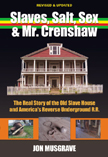One story out of Quincy, Illinois, looks at an artifact that may date back to the earliest French exploration of Illinois.
August 13, 2006 (QUINCY, Ill.) - What's certain is that something's written in the stone. What's less certain is whether the markings have any historical significance.
Now, University of Illinois scientists have agreed to examine the limestone slab some believe proves French explorer Robert Cavelier de LaSalle was the first white man to see the upper Mississippi River in 1671 — two years before Father Jacques Marquette and Louis Joliet made their famous trek.
The other story comes from today's Southern Illinoisan concerning research this summer into the history of the Thebes Courthouse in Alexander County.
A team investigating the Thebes Courthouse had heard of etchings in the beams. But after hours of tiptoeing across the rafters, they decided to give up on finding them.
"It's right there," Alan Hulstedt called out just as they had turned to leave. The senior in architectural studies pointed to the date “1845” carved by a builder into the Southern Greek Revival structure dedicated in 1848.
"One angle, the way the light came in, and it was there," Hulstedt recalled.

No comments:
Post a Comment